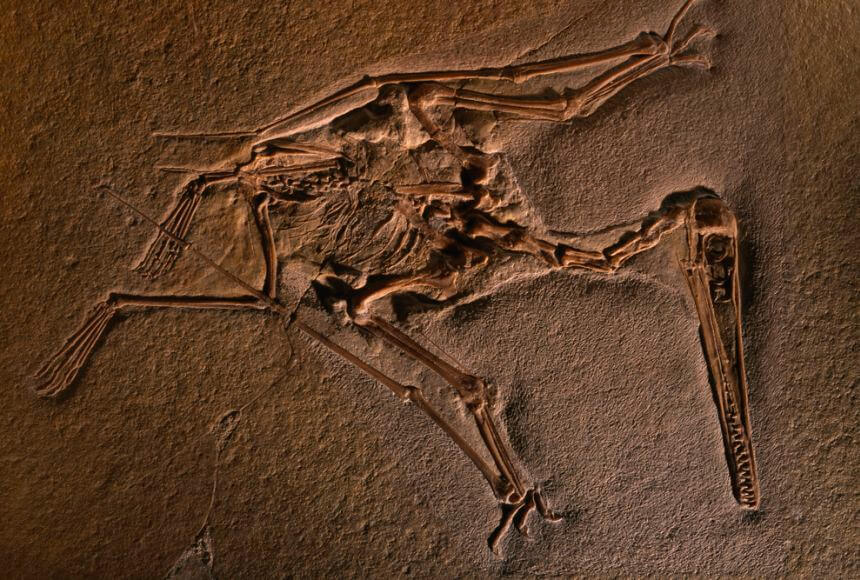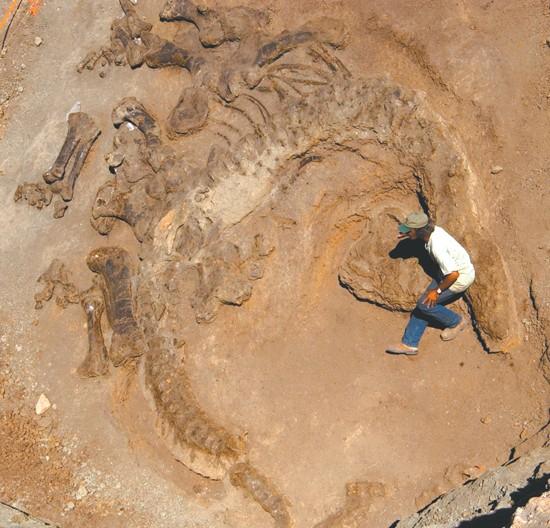Life Behind Dinosaur Fossils
Alan Grant on Feb 2nd 2024
Dinosaur fossils serve as time capsules, preserving the tales of Earth's prehistoric inhabitants. Beyond the awe-inspiring skeletons displayed in museums, there's a world of scientific intrigue, meticulous excavation, and groundbreaking discoveries that breathe life into these ancient remnants. In this exploration of "Life Behind Dinosaur Fossils," we delve into the hidden realm of paleontology, unveiling the secrets, challenges, and triumphs that accompany the quest to understand the creatures that once roamed our planet.

As we delve deeper into the exploration of "Life Behind Dinosaur Fossils," it becomes a captivating odyssey through time and discovery. This journey transcends the boundaries of scientific inquiry, inviting us to witness the tireless efforts of paleontologists as they unravel the enigmatic stories concealed within fossilized remains. Beyond the allure of the skeletons showcased in museums lies a realm where every brushstroke, scan, and debate contributes to the evolving narrative of Earth's ancient inhabitants. This odyssey invites us to appreciate not just the fossils but the dedicated individuals and collaborative endeavors that illuminate the rich tapestry of our planet's history. Join us as we navigate through the hidden corridors of paleontology, where each fossil tells a tale, and every discovery unveils a fragment of the extraordinary saga that is life behind dinosaur fossils.
Topics Covered in the Article
- 1. Unearthing the Past
- 2. Piecing Together Dinosaur Puzzles
- 3. The Paleontologist's Toolkit where Technology Meets Tradition
- 4. The Jurassic Period
- 5. Advancements in Paleontological Techniques
- 6. Paleoecology: Understanding Dinosaur Habitats
- 7. Challenges in Paleontological Research
- 8. Conservation and Ethical Considerations
- 9. Conclusion
- 10. Bibliography
Unearthing the Past

The journey into the world of dinosaur fossils commences at excavation sites, where skilled paleontologists employ precision in unearthing fossils buried for millions of years. According to the Smithsonian National Museum of Natural History, this process involves meticulous planning, sediment analysis, and delicate excavation techniques. The experts carefully document the geological context of each find, preserving invaluable information about the ancient environment and climate. Renowned sites like the Hell Creek Formation in Montana have been vital in unearthing a treasure trove of fossils, providing profound insights into the final chapters of the dinosaur era.
Delicate excavation techniques, akin to a carefully choreographed ballet, are employed. Tools such as brushes, dental picks, and small shovels are used to expose fossils without causing damage. This process requires patience and precision, as layers of sediment are peeled away to reveal the hidden treasures within.
Experts meticulously document the geological context of each find. Not only does this documentation serve as a detailed record for future reference, but it also provides invaluable insights into the ancient environment and climate. Studying the layers of sediment can unveil fluctuations in climate, changes in sea levels, and even catastrophic events that shaped the course of life on Earth.
Piecing Together Dinosaur Puzzles
Once excavated, fossils embark on a transformative journey through cutting-edge laboratories. Here, fossil preparators and scientists utilize advanced technologies like high-resolution CT scanners to peer inside fossils without risking damage. This process has revealed intricate details of soft tissues, allowing scientists to reconstruct more accurate models of dinosaur anatomy. Research studies, such as those published in the journal "Nature," highlight how technology assists in deciphering the mysteries of dinosaur physiology, locomotion, and evolutionary adaptations.
As per a study published in the Journal of Paleontology, fossils unearthed at various sites globally offer insights into different periods and species. The meticulous excavation process ensures that paleontologists can decipher the complex tapestry of life that existed millions of years ago.
The Paleontologist's Toolkit where Technology Meets Tradition
The toolkit of a modern paleontologist seamlessly blends traditional methods with state-of-the-art technology. While brushes and chisels are still fundamental for delicate work, 3D printing and virtual reconstructions are revolutionizing the field. The integration of technology, showcased in studies published in "Paleobiology," enhances precision and allows for the creation of detailed replicas for further study and public engagement. This amalgamation of traditional and modern tools helps paleontologists delve deeper into the past than ever before.
Scientific Debates and Discoveries to Unravel Dinosaur Mysteries

Behind the scenes, scientific communities engage in vibrant debates, challenging existing theories and pushing the boundaries of knowledge. Ongoing research, like that featured in the "Journal of Vertebrate Paleontology," explores the social behaviors of dinosaurs and the dynamics of ancient ecosystems. Debates over topics such as feathered dinosaurs or the coloration of certain species provide insight into the complexities of interpreting fossil evidence. It's a testament to the dynamic nature of paleontology and its commitment to uncovering the truth, even when faced with incomplete puzzles.
The Jurassic period
The Jurassic period was marked by diverse ecosystems and remarkable adaptations among its inhabitants. According to research published in Nature Communications, scientific studies leverage fossil evidence and geological data to unravel the intricacies of Jurassic ecosystems. The focus extends beyond dinosaurs to include prehistoric plants, marine life, and flying reptiles. This comprehensive approach provides a holistic understanding of the interconnectedness of ancient life forms.
Studying Jurassic ecosystems helps scientists appreciate the complex web of life that existed alongside dinosaurs. A study in the Journal of Earth Science and Engineeringdiscusses how the interplay of various species contributed to the dynamic and ever-changing landscapes of the Jurassic world.
Advancements in Paleontological Techniques
Advancements in paleontological techniques have opened avenues for discoveries beyond the bones. According to a study inScience Advances, the remarkable preservation of soft tissues and traces of dinosaur proteins in some fossils provides unprecedented insights. Cutting-edge technologies like mass spectrometry enable scientists to analyze ancient biomolecules, offering a glimpse into the physiological aspects of dinosaurs.
Unveiling the Secrets Within Preserved Soft Tissues
The quest to unveil the secrets held within preserved soft tissues continues to push the boundaries of paleontological knowledge. The study emphasizes that this newfound ability to explore soft tissues offers a more vivid and detailed picture of dinosaurs in their prime. Researchers can now discern details such as skin texture, coloration, and even aspects of the internal organs, providing a level of clarity and understanding that surpasses traditional fossil studies.
This exploration of preserved soft tissues not only enhances our scientific comprehension of dinosaurs but also captivates the imagination, fostering a deeper connection to these ancient beings. The ability to reconstruct more lifelike and dynamic depictions of dinosaurs further enriches the narrative of Earth's history, offering a glimpse into the vibrant and diverse ecosystems that once dominated the planet. As technology continues to advance, the study of preserved soft tissues promises to unveil even more secrets, pushing the boundaries of what we thought possible in paleontological exploration and enriching our appreciation for the extraordinary world of dinosaurs.
Paleoecology: Understanding Dinosaur Habitats
Paleoecology, the study of ancient ecosystems, plays a pivotal role in unraveling the mysteries of dinosaur habitats. Research published in the Journal of Vertebrate Paleontology discusses how scientists reconstruct the environments dinosaurs called home. This interdisciplinary approach integrates paleontological and geological data to piece together the intricate tapestry of prehistoric landscapes.
Interconnectedness of Ancient Life Forms
Understanding the ecosystems in which dinosaurs thrived provides crucial context for comprehending their behavior, interactions, and ultimately, their demise. It's a journey into the past that extends beyond fascination with individual dinosaur species, offering a holistic understanding of the dynamic and ever-changing world they inhabited.
Challenges in Paleontological Research
Funding and Site Conservation
While paleontology holds immense potential for groundbreaking discoveries, it faces challenges that impact the pace and scope of research. A report by the National Academies Press highlights funding constraints as a significant limitation, affecting the scale of excavations and research projects. Meticulous paleontological work demands financial resources for equipment, skilled personnel, and site conservation efforts.
Simultaneously, the preservation of fossil-rich sites is a delicate and complex task. Ensuring the longevity of these sites demands robust conservation efforts, protection from environmental threats, and collaboration with local communities. Limited financial resources, coupled with competing interests for land use, pose hurdles in establishing and maintaining the necessary safeguards. As the field of paleontological research expands, addressing these challenges becomes essential to nurture a thriving and sustainable environment for uncovering the secrets of Earth's ancient past.
Conservation of excavation sites is a critical aspect of responsible paleontological practice. The delicate balance between preserving fossil-rich areas and the need for scientific exploration is an ongoing challenge. Collaborative efforts between researchers, government bodies, and conservation organizations are essential. According to Nature Conservation, ethical guidelines ensure responsible fossil stewardship, minimizing ecological impact during excavations.
Conservation and Ethical Considerations
As dinosaur fossils are uncovered, questions of preservation, ethical considerations, and responsible excavation practices come to the forefront. International initiatives, like those endorsed by organizations such as UNESCO, emphasize the importance of responsible fossil stewardship. Balancing scientific curiosity with environmental conservation, paleontologists work to minimize ecological impact during excavations. Museums play a vital role in education and outreach, with ethical guidelines ensuring that fossils are not only preserved for research but also shared with the public, contributing to a global understanding of Earth's deep past.
Conclusion
The exploration of life behind dinosaur fossils is a captivating journey that extends beyond the allure of skeletal remains. It encompasses meticulous excavation processes, revelations about ancient ecosystems, and challenges in paleontological research. As technological advancements and interdisciplinary collaboration drive our understanding of dinosaurs, the world behind dinosaur fossils continues to unveil its secrets. This journey invites us to explore not only the past but also the intricacies of scientific inquiry and the dedication required to unravel the mysteries of life on Earth millions of years ago.
Bibliography
- Smithsonian National Museum of Natural History. (https://naturalhistory.si.edu/)
- National Park Service: Hell Creek Formation. (https://www.nps.gov/bica/learn/nature/hcf.htm)
- Journal of Paleontology. (https://www.cambridge.org/core/journals/journal-of-paleontology)
- Nature Communications. (https://www.nature.com/articles/ncomms7905)
- Journal of Earth Science and Engineering. (https://www.jese.org/Issues.aspx?ID=38)
- Science Advances. (https://advances.sciencemag.org/content/6/1/eaax4549)
- Journal of Vertebrate Paleontology. (https://www.tandfonline.com/doi/full/10.1080/02724634.2018.1441536)
- National Academies Press. (https://www.nap.edu/read/9857/chapter/1)
- Nature Conservation. (https://www.nature.com/natureconservation)

